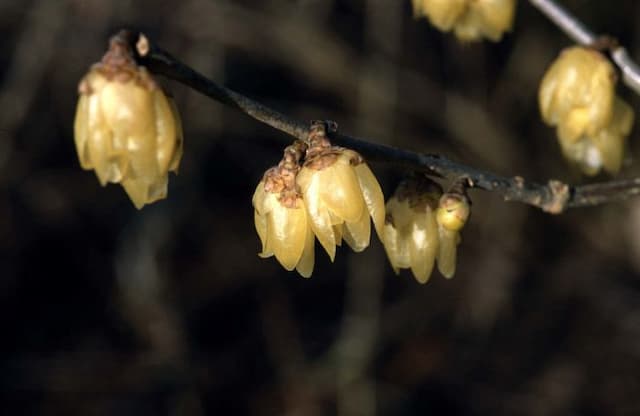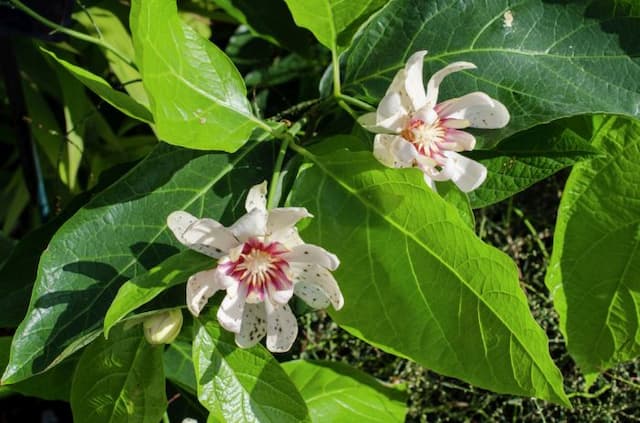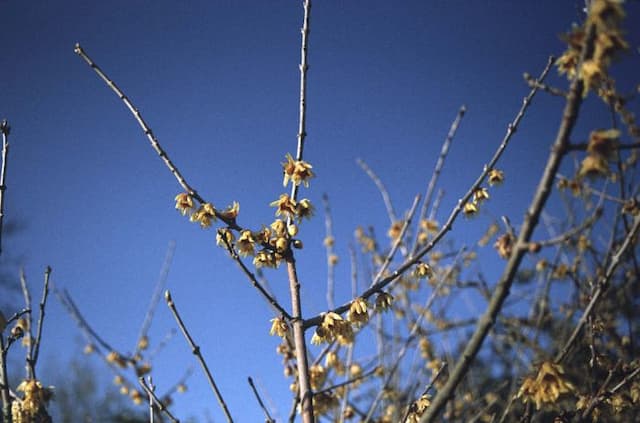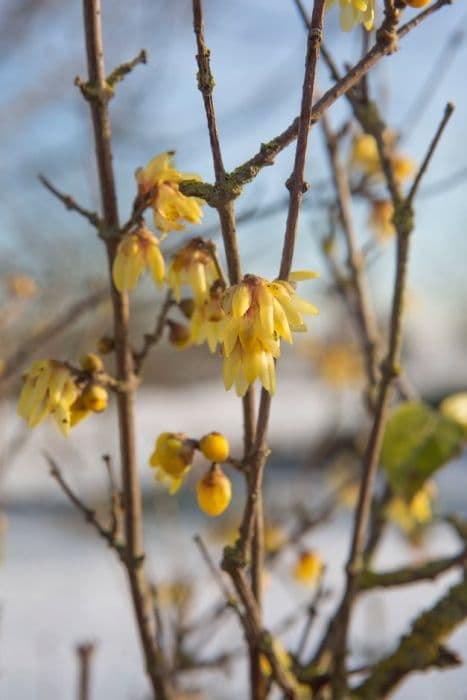Chinese Sweetshrub Calycanthus chinensis

ABOUT
The plant commonly known as Chinese sweetshrub has glossy green leaves that provide a lush backdrop for its remarkable flowers. The flowers have an exotic appearance, with multiple spirals of maroon-colored petals that are sometimes tipped in yellow. These blooms emit a pleasant, fruity fragrance that can often scent the entire garden area surrounding the plant. The petals are thick and waxy, which adds to the plant's overall texture. After the flowering season, the Chinese sweetshrub produces urn-shaped fruit capsules that add an interesting visual aspect to the shrub. As the seasons change, the leaves may turn golden yellow, providing a warm, autumnal display before they fall off for winter. Overall, the Chinese sweetshrub has a rounded form, with branches that can have a somewhat weeping habit. This gives the plant a graceful and elegant appearance.
About this plant
 Names
NamesFamily
Calycanthaceae
Synonyms
Chinese Sweetshrub, Chinese Calycanthus, Eastern Sweetshrub, Strawberry Bush
Common names
Calycanthus floridus var. glaucus, Calycanthus floridus var. oblongifolius, Butneria henryi
 Toxicity
ToxicityTo humans
Chinese sweetshrub, also known as Calycanthus chinensis, has certain parts that are considered toxic if ingested by humans. The main toxic components are present in the seeds of the plant, and possibly in leaves and other parts, although precise toxicity levels may vary. If ingested, the plant can cause symptoms such as nausea, vomiting, dizziness, and in severe cases, seizures or other neurological symptoms. Management of poisoning would typically involve supportive care and symptom management, but because serious cases are rare, there is limited information on all possible consequences.
To pets
Chinese sweetshrub may also pose a risk to pets if ingested. Similar to humans, the plant's seeds contain toxic substances which can affect animals like dogs and cats, potentially leading to gastrointestinal upset, characterized by symptoms such as vomiting, diarrhea, abdominal pain, and occasionally more serious effects such as tremors or seizures. If a pet is suspected of ingesting this plant, it is important to contact a veterinarian immediately to receive proper care and treatment.
 Characteristics
CharacteristicsLife cycle
Perennials
Foliage type
Deciduous
Color of leaves
Green
Flower color
Red
Height
6-10 feet (1.8-3 meters)
Spread
6-12 feet (1.8-3.6 meters)
Plant type
Shrub
Hardiness zones
7
Native area
China
Benefits
 General Benefits
General Benefits- Aesthetic Appeal - Calycanthus chinensis, commonly known as Chinese Sweetshrub, has beautiful, fragrant flowers that enhance the visual appeal of any garden or landscape.
- Attracts Pollinators - The plant's flowers are attractive to pollinators such as bees and butterflies, which are essential for the pollination of many plants.
- Habitat Provision - It can provide shelter and food for various small animals and insects, contributing to biodiversity.
- Drought Resistance - Once established, the Chinese Sweetshrub has a level of drought tolerance, making it suitable for gardens in drier climates.
- Low Maintenance - It generally requires minimal care once established, making it a convenient choice for gardeners of all skill levels.
- Privacy Screen - With its dense foliage, it can be used as a natural privacy screen or hedge in landscaping.
 Medical Properties
Medical Properties- Antimicrobial: Certain compounds in Calycanthus chinensis, like chinensine and calycanthine, have been found to exhibit antimicrobial activity against various bacterial and fungal strains.
- Antioxidant: Extracts from the plant may possess antioxidant properties, which can help in neutralizing harmful free radicals in the body.
- Anti-inflammatory: Calycanthus chinensis may have anti-inflammatory effects that could potentially be useful in the treatment of conditions involving inflammation.
 Air-purifying Qualities
Air-purifying QualitiesThis plant is not specifically known for air purifying qualities.
 Other Uses
Other Uses- Calycanthus chinensis, commonly known as Chinese sweetshrub, can be used in perfumery due to its fragrant flowers. The blossoms have a spicy, fruity scent which is sometimes compared to ripe apples or strawberries.
- The wood of Chinese sweetshrub is sometimes used in fine woodworking for its attractive grain, though the tree is not commonly harvested commercially for this purpose.
- Dried flowers of the Chinese sweetshrub are often incorporated into potpourris and sachets as their scent can be long-lasting when dried properly.
- In landscape design, Chinese sweetshrub can be used as a natural privacy screen or hedge due to its dense growth habit.
- The plant can be used in natural dye production, where the bark may yield a range of color hues for fabrics and crafts.
- Chinese sweetshrub is sometimes planted in outdoor seating areas to provide a natural and pleasant fragrance in the environment.
- The essential oils extracted from the flowers may be utilized in creating homemade scented candles or natural room fresheners.
- Due to its attractive, glossy leaves, the plant can be used in floral arrangements as a foliage accent, especially in the spring and summer months.
- The plant's seed pods, with their unusual and intricate structure, can be used in decorative crafts or as an element in dried floral displays.
- Insect-repelling properties: Some gardeners plant Chinese sweetshrub close to outdoor living spaces with the belief that its aromatic presence may deter certain insects.
Interesting Facts
 Feng Shui
Feng ShuiThe Chinese Sweetshrub is not used in Feng Shui practice.
 Zodiac Sign Compitability
Zodiac Sign CompitabilityThe Chinese Sweetshrub is not used in astrology practice.
 Plant Symbolism
Plant Symbolism- Rarity: Calycanthus chinensis, commonly known as Chinese sweetshrub, is not as commonly found as some other garden plants, symbolizing uniqueness and the beauty of rare occurrences in life.
- Protection: In some cultures, the dense shrubbery of the Chinese sweetshrub is thought to offer protection, symbolizing safety and shelter.
- Love and Attraction: Thanks to its sweet fragrance, this plant is often associated with love and attraction, symbolizing the enticing nature of romance and the allure of deep affection.
- Healing: Some traditional medicinal uses of the plant impart a symbolism of healing and recovery, linking it to physical and emotional health.
 Water
WaterThe Chinese Sweetshrub should be watered regularly to keep the soil consistently moist, but not waterlogged. Typically, watering once a week with approximately 1 to 1.5 gallons of water should be sufficient for young plants, adjusting for rainfall. Mature shrubs may require less frequent watering, depending on weather conditions. During hot or dry spells, additional watering may be necessary, whereas in cool, wet periods, you can reduce the frequency. Always check the top inch of soil for moisture before watering to avoid overwatering.
 Light
LightChinese Sweetshrub prefers full sun to partial shade. Ideally, it should receive at least 4 to 6 hours of direct sunlight daily. Plant the shrub in a location that gets morning sun and light, dappled afternoon shade to protect it from the intense late-day sun. While the plant can tolerate some shade, too little light may result in fewer blossoms and leggy growth.
 Temperature
TemperatureChinese Sweetshrub grows best in moderate climates with temperatures typically ranging from 60 to 80 degrees Fahrenheit. It can tolerate minimum temperatures down to about 20 degrees Fahrenheit, but severe cold may damage the plant. Avoid exposing the shrub to prolonged periods of freezing temperatures for optimal health and growth.
 Pruning
PruningPruning Chinese Sweetshrub is essential to maintain its shape, encourage healthy growth, and stimulate flowering. Prune immediately after the plant has finished blooming, typically in late spring or early summer. Remove any dead or damaged wood, and thin out the center to allow light and air circulation. Regular pruning every year or two will help keep the shrub vibrant and attractive.
 Cleaning
CleaningAs needed
 Soil
SoilChinese sweetshrub thrives in well-draining, loamy soil rich in organic matter. The ideal pH range for the soil should be slightly acidic to neutral, around 6.0 to 7.5. A mix of two parts garden soil, one part compost or peat, and one part sand or perlite would offer a good balance of drainage and fertility.
 Repotting
RepottingChinese sweetshrub does not frequently require repotting as it prefers to be somewhat root-bound. Repotting every 2 to 3 years should be sufficient unless you notice signs of the plant outgrowing its pot or the soil breaking down and impeding drainage.
 Humidity & Misting
Humidity & MistingChinese sweetshrub prefers moderate humidity but is quite adaptable and can tolerate a range of humidity conditions. Aim for an environment with average humidity, avoiding excessively dry or overly humid conditions that could foster fungal growth or desiccation.
 Suitable locations
Suitable locationsIndoor
Bright indirect light, loamy soil, water when topsoil dry.
Outdoor
Full sun to partial shade, rich, well-draining soil.
Hardiness zone
6-9 USDA
 Life cycle
Life cycleChinese sweetshrub (Calycanthus chinensis) begins its life cycle when seeds germinate in the spring after experiencing stratification to break dormancy. Seedlings develop into young plants and establish a robust root system. Throughout the growing season, Chinese sweetshrub enters a vegetative stage, growing leaves and woody stems. Once mature, typically after a few years, the plant undergoes a reproductive phase, producing fragrant reddish-brown flowers, primarily in late spring or early summer. Following pollination, often by beetles, the flowers develop into urn-shaped capsules containing numerous seeds. The plant then enters a period of dormancy in the winter, shedding leaves and conserving energy before resuming growth in the next spring.
 Propogation
PropogationPropogation time
Spring-Early Summer
Propogation: The Chinese sweetshrub, Calycanthus chinensis, is most commonly propagated by semi-hardwood cuttings. This method is best performed in late summer. Take cuttings of about 4 to 6 inches (10 to 15 centimeters) in length from the current season's growth, ensuring each piece has several nodes. Strip away the lower leaves, dip the bottom end of the cutting in rooting hormone to encourage root growth, and insert it into a well-draining soil mix. Keep the soil consistently moist and wait for roots to form, which typically occurs in a few weeks. Covering the cuttings with a plastic bag can help maintain humidity, but be sure to provide ventilation to prevent mold growth.




